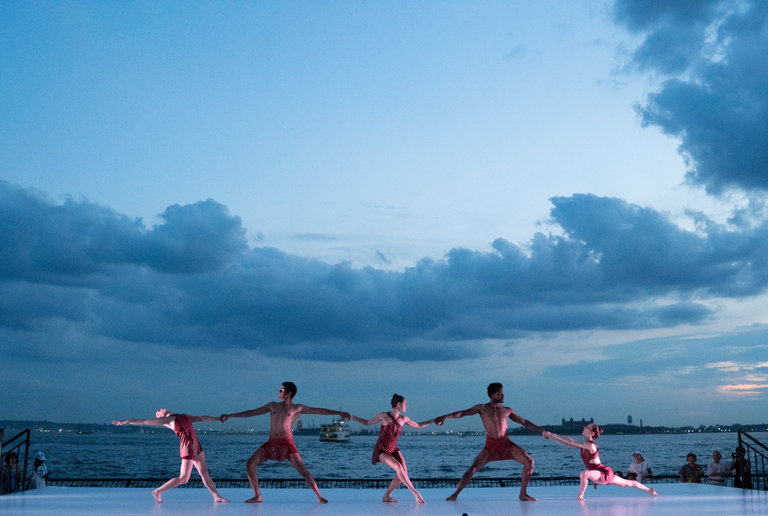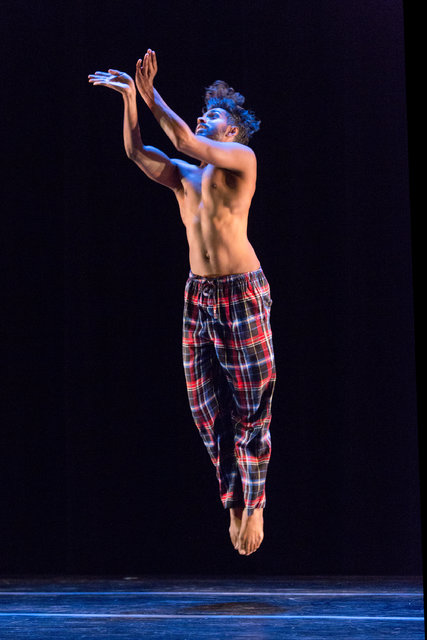
| Broad Hints of Modern Angst at a Festival of Indian Dance | |
| nytimes.com AUG. 16, 2016 |
|
 |
|
Battery Dance Company performing Monday at Robert F. Wagner Park as part of the Erasing Borders Festival of Indian Dance. Credit Sara Krulwich/The New York Times |
|
| Practitioners of Indian classical dance are rightly proud of the ancient heritage they embody. As devoted as they are to gurus and lineage and tradition, though, they are also artists of the present, and many of them, especially the young, long to be innovative, up-to-date, relevant. Whether updating is more positive or more perilous was a live question during this year’s Erasing Borders Festival of Indian Dance. | |
| As in recent years, the festival’s two evenings had contrasting settings. The first, on Saturday, was in the air-conditioned ordinariness of the Michael Schimmel Center for the Arts at Pace University. The second, which was also part of the free Battery Dance Festival, transpired early Monday evening in the heat and humidity of Robert F. Wagner Jr. Park, against the spectacular backdrop of New York Harbor. The outdoor experience felt like sitting in an oven while someone shines a flashlight in your face, but that pain had a payoff when a glorious sunset arrived with cool, crepuscular breezes. | |
| Indoors on Saturday, the discomfort had more artistic causes. In her contemporary solo “rapture/rupture,” Cynthia Ling Lee, who is Chinese-American, gradually exchanged her costume, one suitable to the Kathak dance genre, for jeans and a blouse, while a recorded voice presented her outsider’s discontent with Kathak in its traditional frame of the lover separated from the beloved. Technically weak, the theory-addled piece came off as whiny. When the Japanese-born ballerina Eriko Sugimura used the same frame to express her out-of-placeness, the overwrought emotions weren’t as off-putting, but the mix of barefoot ballet with Indian gestures (with choreography by Shreenath Muthyala) failed to yield expressive benefits. | |
 |
|
| Sooraj Subramaniam at the Michael Schimmel Center for the Arts at Pace University. Credit Richard Termine for The New York Times |
|
| Revanta Sarabhai had more success with simpler modernizing. His absent love was a working woman, and his Bharatanatyam solo cutely incorporated mime, for typing and Skyping, without abandoning the expressive coherence of the traditional form. The dangers of leaving those traditional structures behind were evident in Sooraj Subramaniamís solo, which mixed a chaos of Indian forms with wispy contemporary Western borrowings in an aimless representation of elusive sleep. His cuteness (mime for a late-night trip to the toilet, complete with sound effects) was less sweet. It turned out, though, that Mr. Subramaniam knew what he was abandoning. His Odissi solo on Monday, a sort of physical recitation of the form’s alphabet, showed real skill and beauty. That recitation included poses of languorous temple maidens, so that Mr. Subramaniam was subverting gender binaries, an idea with ancient Indian roots that also counts as trendy. The Colombian-born dancer Carolina Prada approached the same idea from the other side, expressing the interplay of masculine and feminine energies in the universe by dancing the martial, male-dominated form of Chhau with great strength. |
|
| The remaining contemporary experiments were diminishments, including Battery Dance Company’s “The Durga Project,” a collaboration with the Indian dancer Unnath H. R. It was merely decorous, sometimes ingenious in posing, but hardly intense enough for Durga, the goddess of creation and the destruction of evil. | |
| In the end, the traditional selections seemed freshest. The veteran Bharatanatyam dancer Rama Vaidyanathan conveyed all nine of the conventional emotional states in classical Indian theater with dazzling compression. The young Kuchipudi artist Avijit Das presented 10 incarnations of Lord Vishnu with similar precision. Surabhi Bharadwaj’s performance of the snake Nataraj and the cosmic energy symbolized by its sinuous shapes was a highlight. |
|
| And although the musicians accompanying Pandit Krishnan Mohan Mishra failed to sync with him fully, his informal improvisations showed rhythmic spark and avuncular charm. Mr. Spock has nothing on Mr. Mishra for rhythmic eyebrow control. | |
| URL:- http://www.nytimes.com/2016/08/17/arts/dance/broad-hints-of-modern-angst-at-erasing-borders-festival-of-indian-dance-and-battery-dance-festival.html?_r=0 | |